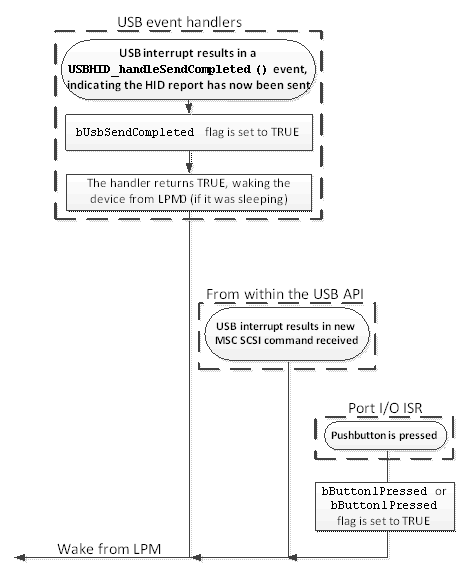SLAU533D September 2013 – April 2017
-
MSP430F5529 LaunchPad™ Development Kit (MSP‑EXP430F5529LP)
- Trademarks
- 1 Getting Started
- 2
Hardware
- 2.1 Block Diagram
- 2.2
Hardware Features
- 2.2.1 MSP430F5529
- 2.2.2 eZ-FET lite Onboard Emulator
- 2.2.3 Integrated Full-Speed USB Hub
- 2.2.4 Power
- 2.2.5 Clocking
- 2.2.6 Application (or "Backchannel") UART
- 2.2.7 Emulator and Target Isolation Jumper Block
- 2.2.8 Isolation Jumper Block: 3.3-V and 5-V Jumpers
- 2.2.9 Isolation Jumper Block: Emulator Connection and Application UART
- 2.3 Measure Current Draw of MSP430 MCU
- 2.4 Using an External Power Source
- 2.5 Using the eZ-FET lite Emulator With a Different Target
- 2.6 USB BSL Button
- 2.7 BoosterPack Plug-in Module Pinout
- 2.8 Design Files
- 2.9 Hardware Change Log
- 3
Software Examples
- 3.1 MSP430 Software Libraries: driverlib and the USB API
- 3.2 Viewing the Code
- 3.3 Example Project Software Organization
- 3.4 USB Configuration Files
- 3.5 Out-of-Box Experience: emulStorageKeyboard
- 3.6 Example: simpleUsbBackchannel
- 3.7 Starting Device Manager
- 4 Additional Resources
- 5 FAQs
- 6 Schematics
- Revision History
3.5.6 LPM0 Exit
When emulating the code, if the device is sleeping, main() execution is seen resting at the LPM0 entry. The demo application can then exit LPM0 and resume execution in response to three different events:
- A SCSI READ/WRITE command has been received. (This happens from a USB interrupt, which can happen at any time.)
- A USB event has occurred. (This happens from the USB event handlers, which are triggered by USB interrupts, which again can happen at any time.)
- One of the LaunchPad development kit pushbuttons has been pressed.
 Figure 30. Waking From LPM0
Figure 30. Waking From LPM0 USB events are like software callbacks, functions called by the USB interrupt service routine (ISR) that the application can choose to service. These handlers are in the file usbEventHandling.c. If the event handler returns TRUE, the CPU remains awake after the USB ISR returns; this causes execution to resume from the point of LPM0 entry, if it had been sleeping there. (If it had not been sleeping, then the resumption has no effect.)
The last event that can wake the CPU out of LPM0 is a pushbutton press. This generates an I/O port interrupt, and the port ISR in hal.c is executed. It includes an intrinsic function __bic_SR_register_on_exit(LPM3_bits); this causes execution to resume from the point of LPM0 entry, if it had been sleeping there. Again, if it had not been sleeping, this resumption has no effect.